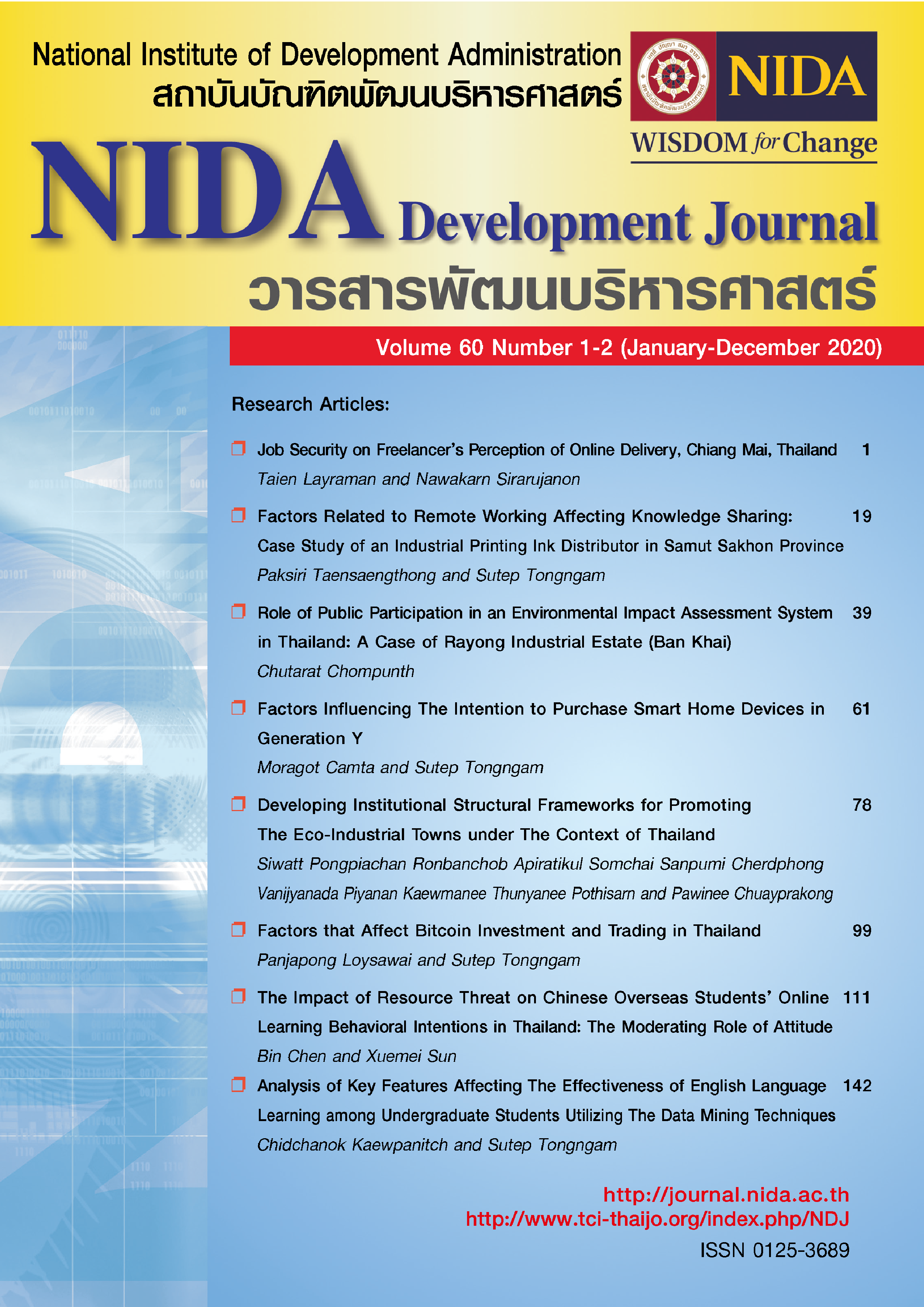Factors Influencing the Intention to Purchase Smart Home Devices in Generation Y
Keywords:
Smart home devices, Intention to purchase, Perception, Generation YAbstract
The objective of this quantitative research is to study the factors influencing the intention to purchase smart home devices in generation Y by collecting the online survey of 400 samples in Thai-land. In order to prove the hypothesis, path analysis has been used to process the data. According to the statistics results, it is obvious that the perceived value directly influences the intention to purchase. The results also reveal that the most positive influencing factor for the people in generation Y is the perceived enjoyment, followed by the perceived compatibility and the perceived usefulness, respective-ly. On the other hand, the most negative one is the perceived fee, followed the perceived technicality. Compared to the literatures, the outputs are consistent with most of them. In term of benefit, business-es could arrange their smart home device campaigns based on the influencing factors to achieve the intention to purchase of their target customers in generation Y.
References
Agag & El-Masry. (2016). Understanding consumer intention to participate in online travel community and effects on consumer intention to purchase travel online and WOM: An integration of innovation diffusion theory and TAM with trust. Computers in Human Behavior, 60, 97-111. doi:10.1016/j.chb.2016.02.038
Chen, J. (2020, 2 25). REAL ESTATE INVESTING. Retrieved July 7, 2020, from Investopedia: https://www.investopedia.com/terms/s/smart-home.asp
Feathermana & Pavlou. (2003). Predicting e-services adoption: a perceived risk facets perspective. International Journal of Human-Computer Studies, 59, 451-474.
Han,Chung,Kim & Youjeong. (2017). Why Consumers Hesitate to Shop Online: Perceived Risk and Product Involvement on Taobao.com. Journal of Promotion Management, 23, 1-27. doi:10.1080/10496491.2016.1251530
https://www.statista.com/outlook/283/126/smart-home/thailand. (n.d.). Retrieved June 27, 2020, from https://www.statista.com: https://www.statista.com/outlook/283/126/smart-home/thailand
Ifinedo & Princely. (2018). Determinants of students’ continuance intention to use blogs to learn: an empirical investigation. Behaviour & Information Technology, 37, 1-12. doi:10.1080/0144929X.2018.1436594
Jamal,Ahmad,Sharifuddin & Juwaidah. (2015). Perceived value and perceived usefulness of halal labeling: the role of religion and culture. Journal of Business Research, 933-941. doi:https://doi.org/10.1016/j.jbusres.2014.09.020
Kim,Chan & Gupta. (2007). Value-Based Adoption of Mobile Internet: An Empirical Investigation. decision Support Systems, 43(1), 111-126. doi:https://doi.org/10.1016/j.dss.2005.05.009.
Kim,Park & Choi. (2017, 4). A study on the adoption of IoT smart home service: using Value-based Adoption Model. Total Quality Management & Business Excellence, 28, 1-17. doi:10.1080/14783363.2017.1310708
Kwon,Trail & James. (2007). The Mediating Role of Perceived Value: Team Identification and Purchase Intention of Team-Licensed Apparel. Journal of Sport Management, 540-554. doi:10.1123/jsm.21.4.540
Mani & Chouk. (2017). Drivers of consumers’ resistance to smart products. Journal of Marketing Management, 76-97. doi:10.1080/0267257X.2016.1245212
Ministry of Public Health, Kor. (2020, 9 24). Gen Y/Gen Me, the group that controls the world's destiny. (n. mongkol, Editor) Retrieved 12 15, 2020, from Department of Mental Health: https://www.dmh.go.th/news/view.asp?id=1251
Nguyen, D. (2015). Understanding perceived enjoyment and continuance intention in mobile games. Information Systems Science, 58.
Ponte,Trujillo & Rodríguez. (2015). Influence of trust and perceived value on the intention to purchase travel online. Tourism Management, 47, 286-302.
Post today. (2019, 4 29). Understanding the difference between 4 generations, breaking the gap for happy work. Retrieved December 21, 2020, from Post today: https://www.posttoday.com/life/healthy/587633
Shin,Sharma,Kim,Kwon & You. (2017). PMIPv6-Based Smart Home IoT Networks. Secure and Efficient Protocol for Route Optimization in PMIPv6-Based Smart Home IoT Networks, 5, 11100 - 11117. doi:10.1109/ACCESS.2017.2710379
Downloads
Published
How to Cite
Issue
Section
License
Copyright (c) 2024 NIDA Development Journal

This work is licensed under a Creative Commons Attribution-NonCommercial-NoDerivatives 4.0 International License.





